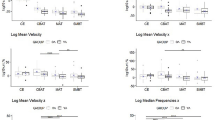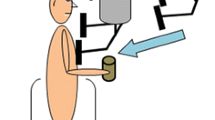Summary
Head movements, ground reaction forces and electromyographic activity of selected muscles were recorded simultaneously from two subjects as they performed the sit-to-stand manouevre under a variety of conditions. The influence of initial leg posture on the magnitude of the various parameters under investigation was examined first. A preferred initial leg posture resulted in smaller magnitudes of head movement and ground reaction forces. EMG activity in some muscles, trapezius and erector spinae, decreased, while in others, quadriceps and hamstrings, it increased in the preferred leg posture. The decreases seen correlate with reductions in head movement observed. The effect of inhibiting habitual postural adjustments of the head and neck, by comparing “free” and “guided” movements was also examined. In guided movements there are significant reductions in head movement, ground reaction forces and EMG activity in trapezius, sternomastoid and erector spinae. It would appear that both initial leg posture and the abolition of habitual postural adjustment have a profound influence on the efficiency of the sit-tostand manouevre. This preliminary study highlights the practical importance of head posture in the diagnosis and treatment of movement disorders, as well as in movement education.
Similar content being viewed by others
References
Abrahams VC (1977) The physiology of neck muscles; their role in head movement and maintenance of posture. Can J Physiol Pharmacol 55:332–338
Abrahams VC (1982) Neck muscle proprioception and motor control. In: Garlick D (ed) Proprioception, posture and emotion, Committee for Postgraduate Eduction. University of NSW, Kensington, NSW, Australia
Abrahams VC, Falchetto S (1969) Hindlimb ataxia of cervical origin and cervico-lumbar interactions with a supratentorial pathway. J Physiol 203:435–447
Alexander FM (1985) The use of the self. Golancz, London
Baid T, Krali A, Turk R (1982) Standing up of a healthy subject and a paraplegic patient. J Biomech 15:1–10
Bakker DA, Richmond FJR (1982) Muscle spindle complexes in muscles around upper cervical vertebrae in the cat. J Neurophysiol 48:62–74
Belinkii VYe, Gurfinkel VS, Paltsev YeI (1981) Elements in control of voluntary movements. Biophysics 12:263–270
Bouisset S, Zattara M (1981) A sequence of postural movements precedes voluntary movement. Neurosci Lett 22:263–270
Christiansen AF, Kardorf U, Bojsen-Møller F (1982) Concentric and eccentric contractions of hip and trunk muscles while seating oneself and rising. Zdvar Vestn [Suppl 1] 51:41–42
Cohen LA (1961) Role of eye and neck proprioceptive mechanisms in body orientation and motor coordination. J Neurophysiol 24:1–11
Cooper S, Daniel PM (1963) Muscle spindles in man; their morphology in the lumbricals and the deep muscles of the neck. Brain 86:563–594
de Jong PT, de Jong JM, Cohen B (1977) Ataxia and nystagmus induced by injection of local anaesthetics in the neck. Ann Neurol 1:240–246
Gahery Y, Massion J (1981) Coordination between posture and movement. TINS 4:199–202
Jones FP (1965) Method for changing stereotyped response patterns by the inhibition of certain postural sets. Psychol Rev 72:196–214
Jones FP, Hanson JA (1961) Time-space pattern in a gross body movement. Percept. Motor Skills 12:35–41
Jones FP, Gray FE, Hanson JA, O'Connell DN (1959) An experimental study of the effect of head balance on patterns of posture and movement in man. J Psychol 47:247–258
Jones FP, Hanson JA, Miller JK, Bossom J (1963) Quantitative analysis of abnormal movement: the sit to stand pattern. Am J Phys Med 42:208–218
Lindsay KW, Roberts TD, Rosenberg JR (1976) Asymmetric tonic labyrinth reflexes and their interactions with neck reflexes in the decerebrate cat. J Physiol 261:583–601
Longet FA (1845) Sur les troubles qui surviennent dans l'equilibrium, la station la locomotion des animaux, après la section des parties molles de la nuque. Gaz Med (Paris) 13:565–567
Lund S (1980) Postural effects of neck muscle vibration in man. Experientia 36:1398
McCouch GP, Deering ID, Ling TH (1951) Location of receptors for tonic neck reflexes. J Neurophysiol 14:191–195
Magnus R (1924) Korpustellung, Springer, Berlin
Richmond FJR, Abrahams VC (1975) Morphology and distribution of muscle spindles in dorsal muscles of the cat neck. J Neurophysiol 38:1322–1329
Richmond FJR, Bakker DA (1982) Anatomical organisation and sensory receptor content of soft tissues surrounding upper cervical vertebrae in the cat. J Neurophysiol 48:49–61
Sherrington CS (1897) Decerebrate rigidity and reflex coordination of movement. J Physiol 22:319–332
Stevens CH (1987) The Alexander Technique, Macdonald, London
Wyke BD (1979) Neurology of cervical spinal joints. Physiotherapy 65:72–76
Yoshida K, Iwakure H, Inoue F (1983) Motion analysis in the movements of standing up from sitting down on a chair. Scand J Rehab Med 15:133–140
Author information
Authors and Affiliations
Rights and permissions
About this article
Cite this article
Stevens, C., Bojsen-Møller, F. & Soames, R.W. The influence of initial posture on the sit-to-stand movement. Europ. J. Appl. Physiol. 58, 687–692 (1989). https://doi.org/10.1007/BF00637377
Accepted:
Issue Date:
DOI: https://doi.org/10.1007/BF00637377




